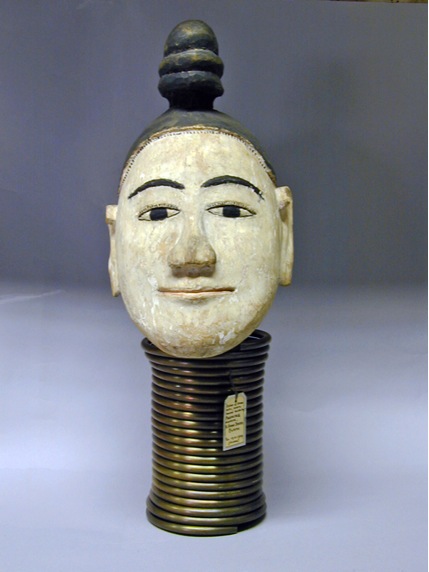Neck Coils
Kayan Lawhi people, Burma (Myanmar), early 20th century
 Purchased from Stevens Auction Rooms in 1929; 1929.92.3This carved and painted wooden head depicts a woman wearing the distinctive brass neck ornament associated with the Kayan Lawhi women of Thailand, and formerly Burma (Myanmar), a sub-group of the Karen ethnic group.
Purchased from Stevens Auction Rooms in 1929; 1929.92.3This carved and painted wooden head depicts a woman wearing the distinctive brass neck ornament associated with the Kayan Lawhi women of Thailand, and formerly Burma (Myanmar), a sub-group of the Karen ethnic group.
From the age of about five, a girl is fitted with a small coil around the neck. According to tradition, not all Kayan girls are entitled to wear them, only those born on auspicious days of the week and while the moon is waxing. It was thought that the rings were separate and just added on top of one another but in fact the ornament is always just one long strip of polished metal, wound into spirals. As the girl grows older, the ornaments are progressively replaced by ones with more coils until marriage when a final tower of coils like the one shown here is worn. These are augmented by smaller sets of rings on the arms and legs as well as heavy ear earrings.
It is a misconception that the neck- rings 'push' the head upward. They are in fact so heavy that they cause the vertebrae to compress, gradually forcing the collarbone and ribcage into an inverted V-shape. This creates the illusion of a proportionally very long neck, and the women are not necessarily much taller than is normal. Herein lies the root of the lowland-Burmese name for the tribe, Paduang, which means, 'long necks'. The neck does not collapse if the rings are removed in adulthood although most women prefer not to do this as the neck is weakened, bruised and discoloured after so many years.
There are several explanations for the neck-rings. One is that they distinguished the Kayan women from those of neighbouring tribes so they could be ransomed back from captivity in times of inter-tribal warfare. Others claim the practice protected the women from tigers, animals that are known to seize their prey by the scruff of the neck. Another story goes that since the Kayans believe themselves to be descended from the Dragon Mother, the rings emulated her magical armour that had the power to cure illness and bestow blessings. Whatever the origins, the neck rings are a potent symbol or power and female beauty in a matriarchal society. The degree of immobilization caused by the rings around the neck, knees and arms mean that that the women excel in more static pursuits such as music and animal training, while the Kayan men bear some of the burdens of childcare and domestic duties.
The Kayan women have, and remain, exploited for their unusual bodily modification. In the early 20th century, the English circus promoter Bertram Mills toured Europe with Kayan women among his exhibited 'freaks'. In their own homeland, Kayan women could be taken captive and loaned to Thai officials who took them across the border to be displayed at carnivals, county fairs, and "beauty contests". Since the civil war in the later 20th century, the Kayan have been forced to flee from Burma to Thailand as refugees and are only allowed to reside in certain areas. Although the wearing of neck-rings had been on the wane, with only a few hundred women retaining them, the Thai government ensured the survival of the custom by promoting the women as a lucrative tourist spectacle. The promise of money and guarantees against deportation back in to the warzone have forced many young Kayan women to revive the wearing of neck-rings despite the physical risks and restrictions, and the loss of much of their original cultural significance. In the late 1990s it was reported that the Kayan women were attracting up to 10,000 new visitors a year to the camps along the Thai-Burmese border.
